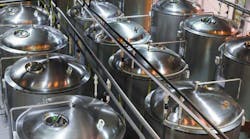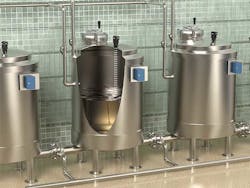Monitoring and managing the contents inside the hundreds of thousands of storage tanks, totes and containers located around the globe in a wide variety of locations and environments can help owners and asset managers improve efficiencies and increase productivity and profitability. This is true for containers installed indoors or outdoors, above ground or below it, and regardless of what the contents are.
A relatively new and effective way to carry out that task is to use wireless connectivity and radar and ultrasonic sensors. They can overcome common challenges related to container location, contents and quantity to give users timely access to accurate level information for better resource allocation and lower costs.
Traditional Methods
Several traditional and low-tech methods and tools such as visual inspections and measuring sticks have long been used to measure levels inside containers. They are easy to implement and require little or no investment in equipment. But they are also reactive, imprecise, prone to errors and labor intensive. And those simple methods can get more costly and time consuming depending on how many tanks must be inspected, how far away the tanks are and the difficulty—even risks—in accessing the tanks. And if technicians must travel to get to the tanks, there may be wear-and-tear on vehicles, travel expenses, and lost productivity of staff.
Traditional level measurements also rely on manual reporting. Data from each tank is collected and recorded by staff at the site. This data is typically logged onto a spreadsheet or entered into a management system when the staff member returns to the office or can access a network connected PC or another device. In many cases, tank data is out-of-date by the time it has been logged.
More Accurate Measurements
Using magnetostrictive floats is a common measurement option that does not depend on human labor. However, these devices must contact the container’s contents to determine their levels. This limits the mechanical life of the device. This also may not be acceptable in applications where contact with measurement tools could contaminate the contents. Additionally, prolonged contact may degrade the performance and accuracy of the float.
Radar and ultrasonic sensors, on the other hand, use electromagnetic or sound waves to detect objects and tank levels, so they do not need to contact the materials they are measuring. They do not rely on light for detection, so they are largely unaffected by conditions that typically challenge photoelectric sensors such as target color, reflectivity, transparency and wet environments. And if the ultrasonic or radar sensors generate proportional analog outputs, they can deliver more accurate measurements which can easily be converted into liters, gallons, feet or meters; this is a preferred method for monitoring tank and container levels.
Collecting Data
Connecting measurement tools to wireless networks is typically less costly than doing so on wired networks. Eliminating the need for wires lets companies cut the costs of installation, alterations and expanding the network. These costs include hardware and labor costs as well as time.
In a basic setup, a wireless node connects to a measuring device, such as an ultrasonic sensor installed on the container. Each node is bound to a wireless controller via an integrated gateway.
Next, a site survey verifies the connection between deployed nodes and the gateway. The system is then configured and inspection parameters and alarm thresholds set. Lastly, an Ethernet or cellular connection is established, giving remote access to the data collected from the tanks to authorized users. A system like this can monitor many containers and be set up with minimal time.
Wireless Benefits
Wireless tank monitors give managers access to timely, accurate information via remote access to the network, providing significant gains in efficiency and productivity. So, rather than sending staff to a site based on forecasted expectations of container levels or by following an arbitrary schedule, managers can strategically plan visits, as well as routes and resources, based on actual needs. This makes it easy to keep tanks filled and processes running without overstocking a site.
In collection or filling applications, this information can prevent overfills and ensure staff and equipment do not need to be sent to a site to empty, move, or remove under-filled containers. For companies providing either of these services, this can mean added capacity from staff and equipment to better serve customers and attract new ones. Additionally, accurate data collected over time can lead to more accurate forecasts that inform business and support decisions.
Remote monitoring can reduce the chances of problems getting out of control. Sudden changes in use, equipment failures or other unexpected events can dramatically change content levels. An empty tank can affect equipment that depends on its contents, and processes may come to an unexpected halt. Overfills can be wasteful, can damage equipment and may have environmental consequences. A wireless system can be easily set to alert key personnel via text or email if tank levels are outside established parameters. This lets workers respond to a problem before it has time to become critical.
Businesses change over time and companies may need to add or remove containers to keep up with new demands. Wireless networks are versatile, highly scalable and can be easily adapted to meet these changes. Containers can be moved as often as needed without altering the system or disconnecting the node and measuring device. Nodes and sensors measuring levels in new containers can be added to a network, or a new network can be deployed to accommodate a new group of tanks, all with relative ease and without incurring substantial costs or large commitments of time and labor.
Although wireless monitoring provides numerous benefits, there are also many reasons facilities may choose to keep or to implement wired sensors. Wired and wireless monitors can also co-exist. The right solution depends on the use and customer needs.
If the liquid level in a facility’s tanks constantly and rapidly changes, it may need a faster level sampling rate than wireless monitoring can provide. Or maybe wireless technology won’t work well due to obstructions or distance between assets. With wired hardware, there’s never a worry about signal strength or sample rates.
For applications that rely on a wired approach, an overlay network, such as Banner Engineering’s Snap Signal, can bring tank-level data onto an industrial network or the cloud. An overlay network connects sensors of all signal types, discrete or analog, letting facility mangers focus on existing tank-level sensors without disrupting the legacy controls. If plant managers need to measure level, temperature and humidity, they can simply add the corresponding sensor. Overlay components convert each of these signals to a smart serial protocol so they can all communicate on a common network. A gateway can be added to gather information in one place and send it wherever it is needed.
Tank monitors that use radar or ultrasonic sensors in a wireless network can be set up quickly, cost-effectively, and without large commitments of human labor or infrastructure changes. They can monitor many containers and be adapted to meet changing needs and scaled to accommodate new containers. Automated alerts, for example, can be set up to notify staff to take action in case of potential problems, minimizing the chance of emergencies developing.
Data generated by these monitors is more accurate and can be accessed from anywhere and at any time. This lets managers make more informed decisions about assets, how they are used, when they should be serviced, and what staff and resources are needed to service them. Finally, if a wired solution works better than wireless for the facility, an overlay network such as Banner’s Snap Signal offers a way to connect sensors of any signal type and convert them to a common communications protocol on the facility’s network or in the cloud.
For more information about wireless sensors for remotely monitoring tank levels, click here.
This article originally appeared in Machine Design, an affiliate publication to Power & Motion.



